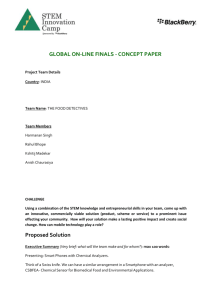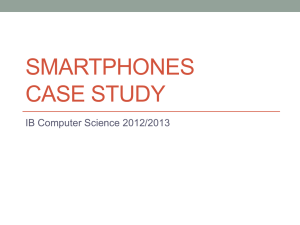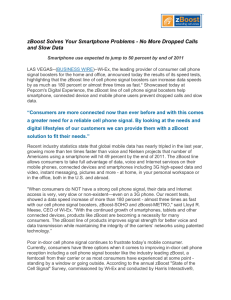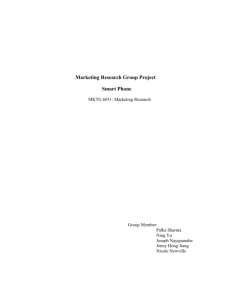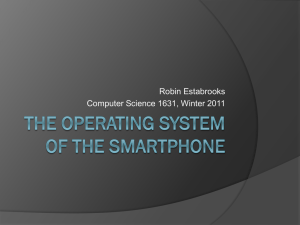New Products and Services
advertisement
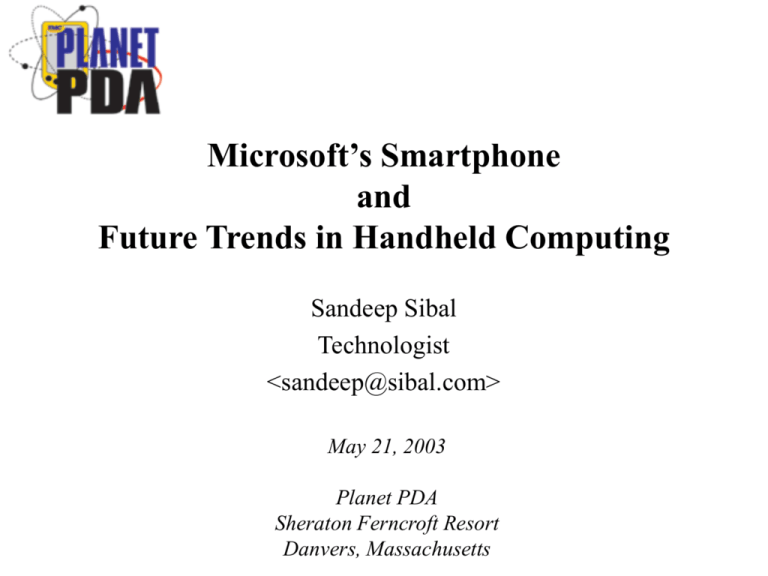
Microsoft’s Smartphone and Future Trends in Handheld Computing Sandeep Sibal Technologist <sandeep@sibal.com> May 21, 2003 Planet PDA Sheraton Ferncroft Resort Danvers, Massachusetts Agenda • Microsoft’s Smartphone – – – – – – – – Why build a Smartphone? Smartphone as PPC successor Smartphone Platform Smartphone UI Applications Using Web Services Smartphone Deployments Obstacles to Dominance • Future Handheld Trends – – – – – – – – The Magic Wand? Limitations User Interfaces Personalization New Technologies Emerging Architectures New Products and Services Concluding Thoughts Disclaimer: This presentation does not reflect Microsoft or any other company’s views. Microsoft’s Smartphone Why build a Smartphone? • Maturity in Microsoft’s core desktop market (Windows, Office, ..) • Continue Microsoft’s growth onto new mainstream devices: – – – – – – Set-top boxes (Ultimate TV) Internet Access (MSN) PDAs (Win CE) Video game consoles (Xbox) Tablets (Windows for Tablet PC) Mobile phones (over a billion phones with improving data capabilities) • Establish “platform leadership” (as on the desktop w/ Wintel) • Commoditize the mobile handset – refocus on software • Drive revenues across other businesses (.NET Web Services and other server-side software) Smartphone as PocketPC (phone ed.) successor 1. Consumer focus - not just for mobile professionals 2. Phone first, PDA second 3. Much smaller form factor 4. One-handed navigation with keypad and joystick 5. No touch screen or stylus 6. Lacks Pocket Word/Excel etc. 7. Emphasis on voice and data communication Available later this year: Smartphone 2003 (powered by WinCE 4.2) has .NET Compact Framework shipping in ROM; Bluetooth; and support for a built-in camera. Smartphone Platform Many familiar Win32 APIs reused: Winsock, TAPI etc. Desktop and PocketPC apps can run on the Smartphone with modifications Apps written for GSM networks may be re-run on CDMA networks Smartphone UI • System Font – 11pt bold Nina • Title Bar – Top 20 pixels • Menu Bar – Bottom 20 pixels – Dynamically changes based on state • Soft Key Menu – Press to display menu – Press to close menu • Message Box – Information or Confirmation • Dialog Box – various controls.. Applications • • • • • • • • Unified Inbox (email, voicemail, SMS, ..) Contacts (address and phone book) Calendar Tasks Pocket Internet Explorer (HTML, WML, ..) MSN Messenger (Instant Messaging) Windows Media Player ActiveSync – USB cable – Over The Air • Games – Solitaire, .. • Smartdial (Telephony) • Numerous 3rd party applications available Using Web Services Very similar to building apps on Win32 or WinCE except that .NET (Compact) Framework functionality is missing. Since a SOAP Toolkit is unavailable, the following classes need to be built: 1. SOAP writer for sending SOAP packets 2. SOAP connector using the WinInet API (HTTP) 3. SOAP reader for reading SOAP packets Example architecture of a Map Mobile Web services Smartphone Deployments Operators and countries*: Europe Handheld 1Q 2003 Mkt: – Orange (UK, France, ..and other PDA (WinCE): 320 K European countries) Smartphone (Win CE): 60 K – Smart (Philippines) “Smartphones” (all**): 860 K – AT&T (USA) – 2003? Palm: 285 K – T-Mobile (Germany) 2003? shelved for now?? Europe Handheld 2003 Mkt Est. – Eurotel (Czech Republic) – PDAs: 2.8million 2003? Symbian/Smartphone: 3.3 million – CECT (Taiwan) – 2003? – O2 (Hong Kong) – 2003? – China Unicom (China) – 2004? *the list of operators is possibly incomplete **this category includes Symbian handhelds Some obstacles to the dominance of Microsoft’s Smartphone Short to mid term: – – – – – – Mid to long term: Software bugs Application signing requirement Expensive logo certification Lack of a Bluetooth API Lack of a Camera API .NET CF not available on Smartphone 2002 – .Net CF apps needs Visual Studio .NET ($$) – Battery life – PC design (personalization,..) – From a horizontal to a vertical mkt? – Concerted resistance by the growing Symbian camp – Operator’s walled garden approach… despite branding. Widely varying analyst predictions over the next few years: from leadership to annihilation! Future Trends in Handheld Computing The Magic Wand ? Cross-functional value of integrating functionality is significant. Market for PDAs is stagnant, but for telephony-enabled smartphones is rising! Some Fundamental Limitations • User mobility – Importance of non-visual data input and output while moving; e.g., speech interface – Occasional loss of wireless connectivity • Form factor: Maximum size – Hand-held – Ease of Portability • Form factor: Minimum size – Eyesight (screen) Projection screens only if immobile – Tactile data input Canesta-type data input only if immobile These fundamental limitations bound what will be possible in the future on handhelds User Interfaces • Ergonomic physical design is critical – not a shrunk computer! • Optimized for use (e.g., n-gage) • Multiple modes of interaction* – flexible data input and output depending on user situation, task, or connectivity: – – – – – GUI Speech Gesture Handwriting Gaze? *See the W3C Multimodal Interaction Working Group for efforts to standardize such interfaces. Also see Kirusa’s website for demonstrations of multimodal interfaces on various handhelds. Personalization Unlike a computer, you “wear” your handheld all the time. It is a personal statement of who you are. Its look and feel are therefore very critical. Some aspects are: • Faceplates • Fashion phones (e.g., Matrix phone) • Polyphonic Ring-tones • Skins • Background images • Screen savers • Multiple profiles (indoor, outdoor, meeting, ..) • Flashing lights • Customized Vibrations? New Technologies Moore’s law and the maturation of existing and future scientific discoveries & inventions will substantially improve the handheld’s capabilities with respect to: • CPU & Memory • Screen displays (OLED, E-ink microcapsules, ..) • Cameras (2Megapixel cameras < $200) • Microphones (minimize background noise) • Speech recognition and synthesis • Gesture and handwriting recognition • Location based technologies • Sensors (pressure, temperature, chemical, biological,..) • Personal (health and fitness) • Battery life (also liquid fuel, and nuclear!) • Bandwidth (EDGE, EVDO, lower cost Wi-Fi!) • Audio/Video and other real-time streaming capabilities (VoIP, HDTV, ..) • 2D and 3D rendering (especially for games) • Security (biometrics, crypto..) • Increased cross-connectivity across various functionalities Emerging Architectures • Coupling of hardware-centric functional modules – Fused into the handheld (e.g., Camera-phones) – Expansion slots (e.g., CF slots) – Personal Area Network (e.g., Bluetooth). See IXI’s PMG. – Promiscuous binding with surrounding capabilities (Project Oxygen) • How will these architectures evolve? • Location of Computation – Embedded (computed locally in the handheld). Can operate in disconnected mode. Limited by CPU, memory, battery power. – Network (computed in network). More compute resources but limited by connectivity, bandwidth & latency. – Distributed. Part-embedded, partnetwork based. (e.g., Distributed Speech recognition) • How will these architectures evolve? New Products and Services • • • • Numerous new products (Nokia, Sony-Ericsson, Samsung, LG, Kyocera, Fujitsu-Siemens, HTC, Compal, Panasonic, Hitachi, NEC, Toshiba, Audiovox, Sendo, Danger, RIM, HPCompaq, Palm, Handspring, ..) - with a multitude of designs and features. Innumerable companies working on novel applications and services. Difficult to predict new innovations and their success in the marketplace. Sources of innovation: – – – – Researchers tinkering with new technologies (e.g., Transistor) User Need (e.g., Tim Berners Lee and the World Wide Web) Repurposing existing technologies (e.g., GPS for LBS) Services arising from new market segments (e.g, oddball digital merchandise: Pokemon characters) – Innovations arising from unusual situations (e.g., Rollerboards due to the California drought) • Some major near-term emerging services: – Location based services (Sprint’s E-911 A-GPS, AT&T Find Friends, Motorola’s ViaMOTO, ..) – Rich-media messaging and conferencing (Multimedia messaging, Video clips,..). Bandwidth currently limiting adoption. • Enterprise applications such as CRM, SFA and FFA may well drive some of the newer (and often more expensive) services before they are readied for the mass market. Concluding Thoughts • Handhelds are becoming a multi-purpose magic wand. • Handheld functionality will continue to improve substantially within the limitations of form factor and mobility • User interfaces and personalization are critical for success in the marketplace • Handheld computing will benefit substantially from new technologies and Moore’s law. • Multiple architectures will compete and co-exist in the coming years. • New products and services will arise from unexpected places Thank You Reminder: • Please be sure to complete your session evaluation forms and place them in the box outside the room. We appreciate your feedback.

